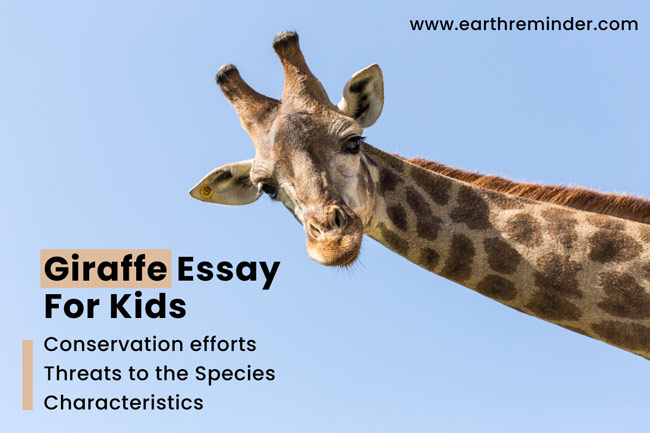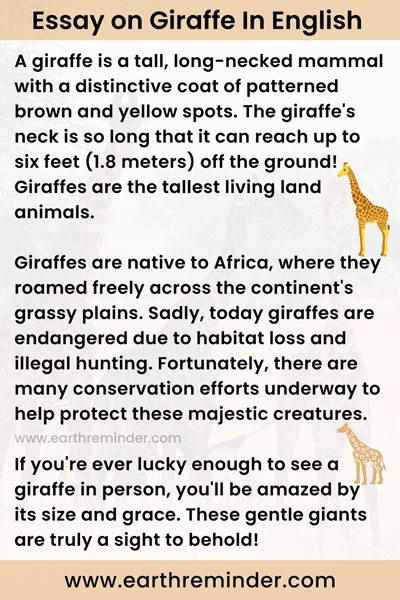Giraffes are incredible creatures with their long necks and spotted coats, but they’re much more than that. This giraffe essay explores the fascinating world of giraffes and provides kids and students with an in-depth look at these majestic animals. Learn about their behavioral traits, physical characteristics, breeding, and conservation efforts – an interesting journey through nature!
Table of Contents
Introduction to Giraffe Essay
When you find an animal that has a tall neck and long legs and brown patched skin, it surely must be a giraffe. Giraffes are the tallest mammals on Earth, with males reaching heights of up to 18 feet and females reaching heights of up to 14 feet. These majestic animals are native to the savannas and woodlands of Africa, where they can be found in countries such as Chad, Niger, and South Africa. Despite their impressive size and striking appearance, giraffes are often overlooked in popular culture and are not as well-known as other African wildlife, such as lions and elephants.
Giraffe Physical Characteristics
One of the most distinctive features of giraffes is their long necks, which are made up of seven vertebrae, just like in humans. However, the vertebrae in a giraffe’s neck are much larger and heavier than those in a human’s neck, and they are connected by special elastic-like tissue called ligaments.
Giraffes use their long necks (up to 6 feet) to reach high into trees to feed on leaves, twigs, and fruit. They can reach the highest branches, and can also rotate their heads 180 degrees to give them a 360-degree view of their surroundings. Giraffe’s tongues are approximately half a meter long, ranging between 45 cm and 55 cm in length.
Giraffes are herbivores, and they mainly feed on leaves, twigs, and fruit from acacia and mimosa trees. They have a four-chambered stomach that helps them digest their tough, fibrous diet, and they can go for long periods without drinking water because they get most of their hydration from the moisture in their food.
They can consume up to 75 pounds of food per day, and they spend most of their time feeding and resting to conserve energy.
Giraffes Breeding Patterns
Giraffes are social animals, and they live in herds of up to 20 individuals, consisting of both males and females. The females are led by a dominant female, who is responsible for making decisions for the group, such as where to go to find food and water. The males, on the other hand, are more solitary and tend to leave the herd once they reach sexual maturity at around four or five years old.
Giraffes have a unique breeding system, in which males will participate in a behavior known as “necking,” in which they will swing their necks at each other to establish dominance. The winner of the necking contest will then mate with the females in the herd.
Female giraffes give birth standing up, and the newborn, called calves, are born with a weight of around 150 pounds and a height of about six feet. Calves can stand and walk within an hour of being born, and they can start feeding on solid food within a few weeks.
Threats to the Species
Despite their impressive size and strength, giraffes are not immune to threats. They are vulnerable to predators such as lions, leopards, and hyenas, and they are also at risk from humans, who may hunt them for their meat, hide, or bones.
Giraffes are also threatened by habitat loss due to the expansion of agriculture and urbanization. As a result, giraffes are classified as a “vulnerable” species by the International Union for Conservation of Nature (IUCN), and their populations have declined by almost 40% in the past 30 years.
In addition to the threats that giraffes face from predators and habitat loss, they are also facing a new challenge: climate change. As temperatures rise and rainfall patterns change, the habitats of many species, including giraffes, are being disrupted. This can lead to food shortages, dehydration, and increased competition for resources, which can have negative impacts on giraffe populations.
Another threat to giraffes is the illegal wildlife trade, in which animals are captured and sold for profit. Giraffes are often targeted for their hides, which are used to make clothing and other products, and for their bones, which are believed by some to have medicinal properties. The illegal trade in giraffe parts is a major contributor to the decline of giraffe populations, and it is important to take action to stop it.
Conservation Efforts
Fortunately, there are many organizations and individuals working to protect giraffes and raise awareness about the threats they face.
The Giraffe Conservation Foundation (GCF), for example, is a leading organization dedicated to the conservation and protection of giraffes. Another organization working to protect giraffes is the African Wildlife Foundation (AWF), a leading conservation organization focused on protecting Africa’s wildlife and wild lands.
Also, to protect giraffes and ensure their survival, conservation efforts are underway in various parts of Africa. These efforts include protecting giraffe habitats, monitoring their populations, and educating local communities about the importance of wildlife conservation. In addition, some organizations are working to relocate giraffes to areas where they can thrive and repopulate, to boost their numbers and improve their chances of survival.
One example of a successful giraffe conservation effort is the Samburu Giraffe Sanctuary in Kenya, which was established in the 1980s to protect the endangered reticulated giraffe population in the region. The sanctuary is home to around 150 giraffes, and it offers guided tours to visitors, who can learn about the biology, behavior, and conservation of these majestic animals.
The sanctuary also works with local schools and communities to educate people about the importance of giraffes and other wildlife, and it engages in habitat restoration and reforestation efforts to improve the local environment for giraffes and other species.
In addition, people also contribute to the protection of this beautiful animal by participating in World Giraffe Day on the 21st of June every year.
Giraffe Essay Conclusion
To conclude a giraffe essay: The giraffe is an amazing animal that has captured people’s attention for centuries. Whether it’s its long neck and striking appearance or its distinctive eating habits, the giraffe inspires our passion for wild animals. However, they face numerous threats, including predators, habitat loss, and hunting, and they are classified as a “vulnerable” species by the IUCN. Conservation efforts, such as the Samburu Giraffe Sanctuary in Kenya, are working to protect giraffes and ensure their survival for future generations. It is clear that without our efforts, giraffe populations will continue to decline and may soon reach a threshold where recovery is no longer possible. It’s critical that we act now before it’s too late to ensure these wonderful creatures have a safe place on the planet for years to come.
As a study guide for your exams and competitions, we hope you have found this essay on giraffe in English helpful. If you like it, please share it with other students and classmates.

